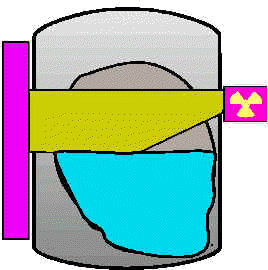Nuclear level sensor controls are used for point and continuous measurements, typically where most other technologies are unsuccessful.
The radioisotopes used for level measurement emit energy at a fairly constant rate but in random bursts. Gamma radiation, the source generally used for nucleonic level gauging is similar to microwaves or even light (these are also electromagnetic radiation, but of lower energy and longer wavelength)…
The short wavelength and higher energy of gamma radiation penetrates the vessel wall and process media.
A detector on the other side of the vessel measures the radiation field strength and infers the level in the vessel.
Different radioisotopes are used, based on the penetrating power needed to “see” the process within the vessel. With single point gauges the radiation provides a simple on/off switching function, whereas with continuous level measurement the percentage of transmission decreases as the level increases.
Nuclear Level Sensor Theory, Advantages and Disadvantages

Advantages
As no penetration of the vessel is needed there are a number of situations that cause nucleonic transmitters to be considered over other technologies.
These applications generally involve high temperatures / pressures or where toxic or corrosive materials are within the vessel. Placing the source and / or detector in wells within the vessel can reduce source sizes.
An extension of this is to use a moving source within the vessel; this facilitates the unique ability to combine density profiling with accurate tracking of a moving interface.
Disadvantages
It would appear that nucleonic gauges provide a truly universal “fit and forget” level measurement technology. Although when the “cost of ownership” is calculated nuclear level measurement is often more expensive than conventional systems.
Hidden costs include initial licensing and periodic surveying. These services are usually provided by external authorities or by the equipment supplier, assuming they have appropriately qualified staff. If no longer required, the nucleonic gauge must be disposed of through appropriately licensed, external organizations, which again can be a costly exercise.
Practical Notes
From a psychological standpoint, the radiation symbol found on these controls is frequently the cause of unfounded concern with uninitiated plant personnel.
Plant Management is usually required to ensure that appropriate education is given to any staff likely to be involved with this measurement technology. Source size regulations can often be met in difficult applications by placing the source and / or detector in wells within the vessel if necessary.